  EM Senior Advisor Ike White provides remarks to the audience during day two of the forum.
JAPAN – Senior Advisor William “Ike” White and others with an EM delegation traveled to Japan to attend the 7th International Forum on the Decommissioning of the Fukushima Daiichi Nuclear Power Station (NPS) this week to engage with experts from Japan and other countries.
The event provided an opportunity to learn the latest progress of the Fukushima Daiichi NPS cleanup and share information related to technical aspects and stakeholder engagement during decommissioning and remediation of nuclear legacy sites in the United States.
“This event brings together such a tremendous wealth of knowledge, expertise and experience. Listening to presenters and to other participants at the forum has been very informative. Through our international partnerships, we can continue to work together and learn from each other,” said White.
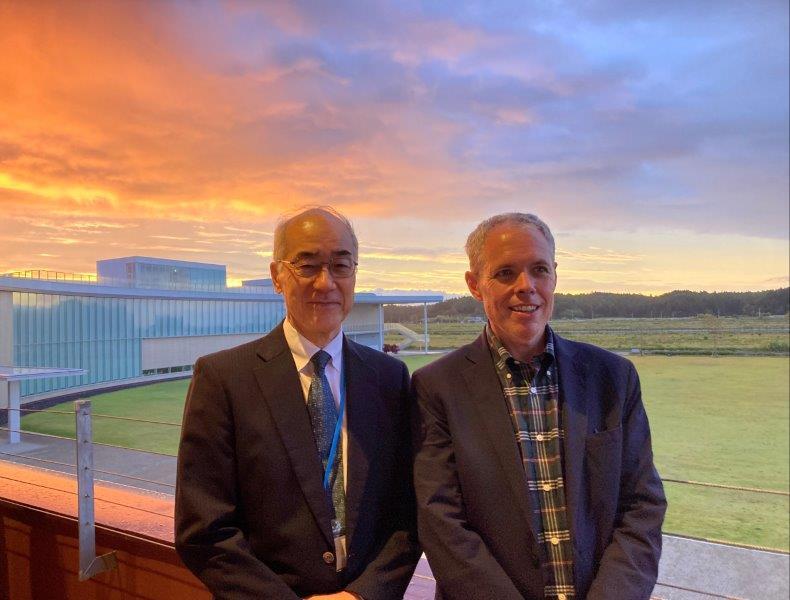 Dr. Hajimu Yamana, NDF president, and Ike White, EM senior advisor, at the end of day one of the forum in Fukushima prefecture.
The two-day event was hosted by the Japan Nuclear Damage Compensation and Decommissioning Facilitation Corporation (NDF) to provide a forum to discuss the Fukushima Daiichi decommissioning and the future of the community. Over 500 attendees participated over the course of the two-day event.
The first day featured a panel with Japanese and international government and industry leaders, and local community members to engage in a question-and-answer session regarding the cleanup. The panel included local high school students who voiced their desire to imagine a new future for Fukushima prefecture impacted by 3/11; how the earthquake, tsunami and subsequent nuclear accident are referred to by Japanese people. The conversation was captured by a story mapper who recorded the dialogue using pictures, words and symbols.
 |
|
A story mapper provided a summary to conclude day one of the forum. Consecutive translations were provided via headsets to attendees. |
The program for the second day gave technical experts the opportunity to discuss the full-fledged debris retrieval at the Fukushima Daiichi NPS. The venue also housed a technical abstracts poster session, including a poster that was produced in collaboration with the Idaho National Laboratory.
Masaki Nakagawa, special adviser to executive directors, NDF and Ike White, EM senior advisor, look at a technical abstract poster during day two of the forum that was produced in collaboration with the Idaho National Laboratory. |
|
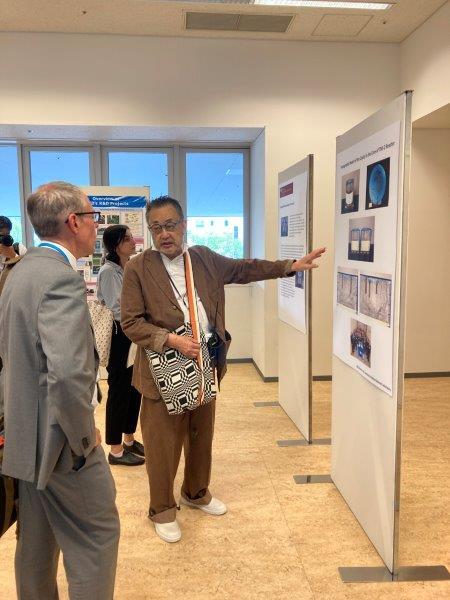 |
“12 years and 5 months have already passed since the nuclear accident. I would like to express my respect to the efforts of the local people who have been working step by step toward reconstruction despite difficulties. In parallel with the progress of reconstruction, significant progress has been made in the response to the decommissioning,” NDF President Dr. Hajimu Yamana said in opening remarks on day two in Iwaki, a city located in Fukushima prefecture near the Fukushima Daiichi NPS where the EM delegation participated in a tour.
Pictured at the Fukushima Daiichi NPS during a tour, from left are Masaki Nakagawa, special adviser to executive directors, NDF; Ike White, EM senior advisor; Kristen Ellis, acting associate principal deputy assistant secretary for the Office of Regulatory and Policy Affairs and director of Regulatory, Intergovernmental, and Stakeholder Engagement; Cathy Tullis, chief of staff; and Karen Edson, public affairs specialist. |
|
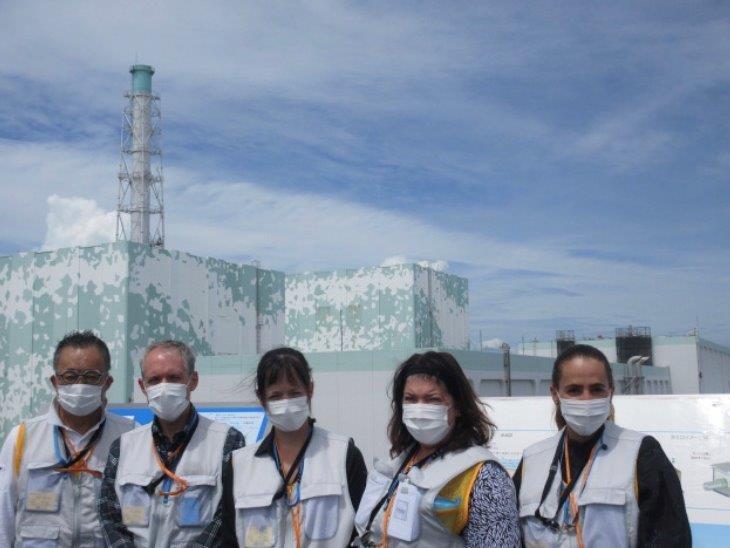 |
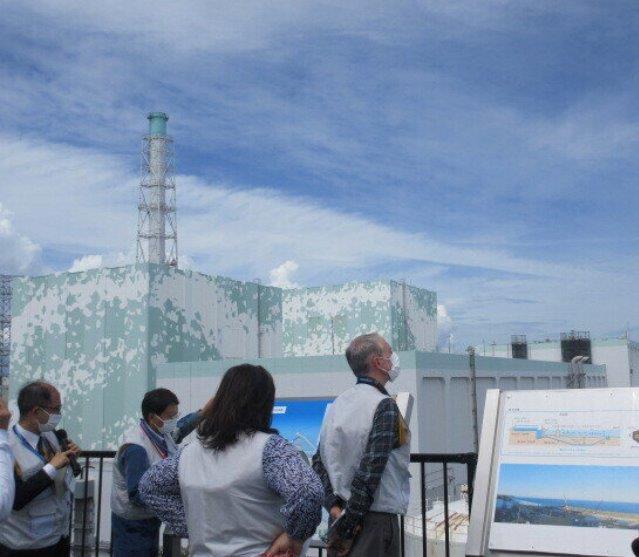 |
|
Ike White, EM senior advisor, and delegation view the progress underway at the Fukushima Daiichi NPS. |
White noted the progress of the Fukushima Daiichi NPS cleanup he observed first-hand in remarks delivered on the second day of the forum.
“The U.S. is very grateful for the work undertaken by NDF and the success already achieved in the Fukushima cleanup,” White said.
Such engagements between EM and Japanese officials and stakeholders are not new. EM officials joined other government and industry representatives to explore potential collaborations between the U.S. and Japan in workshops held in 2020. Those workshops, which focused on decommissioning work in Japan, were hosted by Japan’s Ministry of Economy Trade and Industry and supported by EM’s Office of Intergovernmental and Stakeholder Programs. A year earlier, EM hosted a tour at the Idaho National Laboratory Site for Japanese engineers helping with the cleanup of the 2011 accident.
“It is truly an honor to be invited to Japan and given the opportunity to speak at the Fukushima forum and engage with our Japanese partners. Together we benefit from our exchanges of best practices, technology and expertise” White said.
 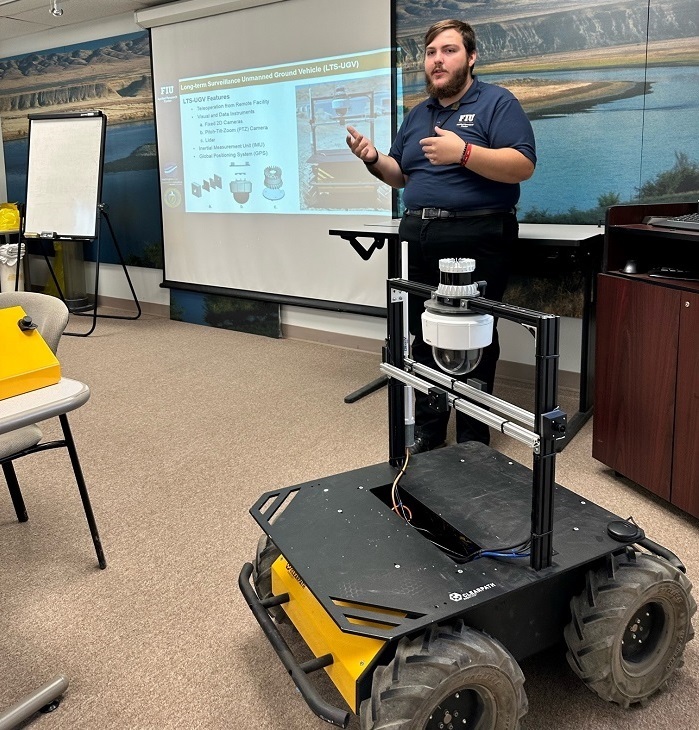 DOE Fellow Brendon Cintas presents a robot he modified to better serve EM’s mission at the Hanford Site after adding multiple cameras, data-collection technology and remote-control capability, during a recent demonstration at Hanford.
RICHLAND, Wash. – EM has partnered with Florida International University (FIU) to build DOE’s workforce while furthering the Hanford Site cleanup mission.
EM collaborates with FIU to offer paid research opportunities and summer internships for minority-student scientists and engineers across the cleanup program’s facilities.
EM Office of River Protection (ORP) contractor Washington River Protection Solutions (WRPS) sponsored one such opportunity by sending a robot that it had previously purchased for radiation mapping to FIU in March 2023 so students could explore enhancing the robot’s capabilities and potential uses. Brendon Cintas, a mechanical engineering graduate student and DOE Fellow, went to work repurposing the technology to enhance the tools available for monitoring Hanford’s large underground waste tanks.
“Rather than it being specifically a tool for surveying and radiation mapping, we wanted it to be a multifunctional tool that could be deployed with a variety of uses,” said Cintas. “We basically hit the reset button and rebuilt the robot from the ground up.”
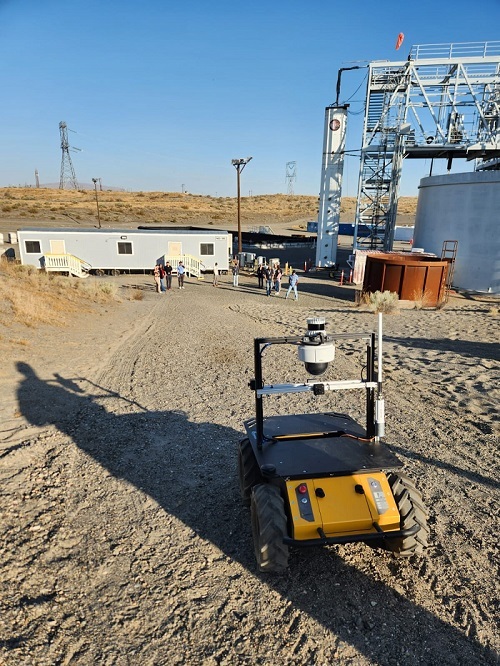 |
|
A robot used on the Hanford Site is remotely controlled and can be equipped to complete various tasks in conditions that might be hazardous for humans. |
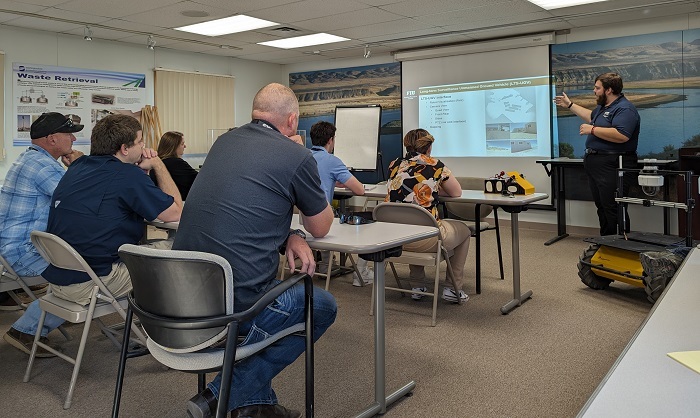 EM partners with Florida International University to offer paid research opportunities and summer internships for minority-student scientists and engineers across EM facilities, like this robot Brendon Cintas is developing to help monitor large underground waste tanks at the Hanford Site.
Working with WRPS engineers, Cintas and his team adapted the tool to better serve the Hanford mission, adding multiple cameras, data-collection technology and remote-control capability. The base vehicle was built to be compatible with a variety of plug-and-play components, allowing for multiple options to tackle different objectives.
Cintas and his team recently demonstrated the robot at Hanford.
“Brendon’s commitment to advancing technology for nuclear facility monitoring has greatly contributed to achieving both safety and excellence,” said Doug Reid, a WRPS mechanical engineer who advised Cintas throughout the project. “WRPS’ continued support for sponsoring DOE-FIU Fellows has been instrumental in fostering young talent and driving groundbreaking advancements in the field. I am proud to be a part of this work.”
Cintas and other students will continue developing the robot at FIU. Planned improvements include adding more data-gathering technology, improved cooling, weatherproofing, radiation shielding, additional cameras, and a more agile base. These modifications will enable the robot to generate radiation maps with greater precision, monitor air quality and traverse more challenging terrain.
-Contributor: Derek Miceli
 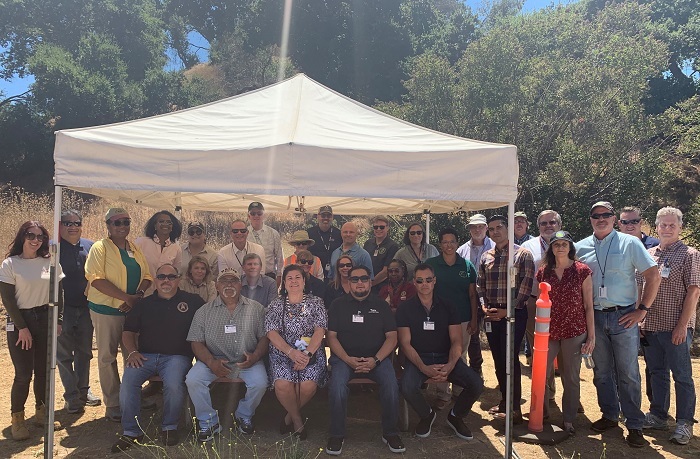
SIMI VALLEY, Calif. – The Santa Susana Field Laboratory (SSFL) Sacred Sites Council recently met with senior leaders from the State of California and the parties managing the cleanup at SSFL. The council is comprised of tribal leaders from the Santa Ynez Band of Chumash Indians; Feranadeño Tataviam Band of Mission Indians; Kizh Nation, Gabrieleño Band of Mission Indians; and Barbareño/Ventureño Band of Mission Indians. State officials attending the meeting included Moises Moreno-Rivera, deputy secretary for Environmental Justice, Tribal Affairs and Border Relations, California Environmental Protection Agency; Meredith Williams, director of the California Department of Toxic Substances Control; and Julianne Polanco, state historic preservation officer. EM manages the cleanup work at the Energy Technology Engineering Center in Area IV alongside SSFL cleanup partners NASA and Boeing. The tribes requested the meeting, presenting an opportunity for local tribal leaders to share important cultural history and meaning of the sacred sites at SSFL with meeting attendees. The council meets regularly and provides guidance regarding areas of cultural importance. Council members discussed the deep religious and cultural significance of their annual pilgrimage to this site, a tradition their ancestors may have practiced for thousands of years.
 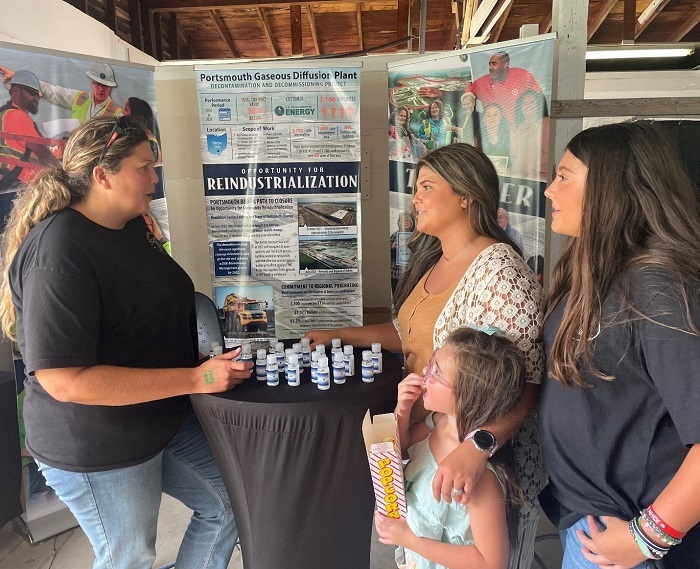 Portsmouth Site employee Kristen Martin, left, speaks with fairgoers at the Scioto County Fair about project progress and Fluor-BWXT-Portsmouth’s involvement in community activities.
Across the country, county fairs provide an opportunity for citizens to come together and build camaraderie. Each year, EM's Portsmouth Site joins neighbors in these local events as a means of community building and outreach.
Fluor-BWXT-Portsmouth (FBP), decontamination and decommissioning contractor for the Portsmouth Site, sets up a booth at the Pike, Scioto and Ross county fairs. Site employees volunteer to work shifts and speak with the public about progress at the site, economic development in the community and educational outreach.
The booths, which feature a video highlighting milestones and community involvement from the previous year, receive thousands of visitors over two weeks.
“The video is always a highlight of the booth. It helps the public understand our work and gain an appreciation for our commitment to safety and the community,” said FBP Site Project Director Greg Wilkett. “The conversations our volunteers have build relationships and foster a greater understanding of what we are doing and how that impacts the future.”
The booths are popular with employees and retirees who get a chance to add visuals to the stories they’ve shared with family and friends.
“One of my favorite things is when a retiree stops by and shares stories from the past,” said fair volunteer and Portsmouth Site employee Kristen Martin. “They enjoy getting a chance to talk about their job. It’s clear to see how proud they are of their work at the site.”
Portsmouth Site Lead Jeremy Davis added that county fairs are an important event for southern Ohio communities.
“As members of the community, we want to support our local county fairs, as well as provide an opportunity for our neighbors to ask questions and learn more about the Portsmouth Site,” he said.
While working the fairs is an excellent community outreach opportunity for the site, it takes a tremendous amount of planning and volunteer involvement. This year, nearly 60 employees served three county fairs for more than 300 hours.
-Contributor: Cindi Remy
  An aerial view of the legacy facilities in the Savannah River Site’s F Area. Those facilities include the F Canyon Chemical Separations Facility and the F Area Analytical Laboratories, which are being deactivated.
AIKEN, S.C. – Contractor employees supporting the EM program at the Savannah River Site (SRS) recently reevaluated deactivation plans for legacy facilities in the site’s F Area, prompting a change in direction resulting in significant cost savings.
F Area is home to several legacy nuclear facilities and support buildings no longer used for processing nuclear material, including the F Canyon Chemical Separations and F Area Analytical Laboratory facilities. F Area also includes Building 235-F, which was used to process plutonium used in space exploration. The area is undergoing cleanup and closure to make room for the new Savannah River Plutonium Processing Facility and to help EM reduce its cleanup footprint at SRS.
Three legacy buildings in F Area are being deactivated. Two of those buildings were home to the F Area Analytical Laboratories, whose capabilities were moved to another location at SRS in 2020. The third is home to the chiller plant, which provides chilled water needed for conditioned air — either heated or cooled air depending on the season — to the former laboratory buildings.
Initial plans called for deactivating those three buildings by individual zones to reach final end-state objectives, or endpoints, according to Trey Gilland, manager of the Laboratory Deactivation Project with Savannah River Nuclear Solutions (SRNS), the managing and operating contractor at SRS.
“The plan was to deactivate the high-hazard, highly contaminated zones first, working our way out to the lower-hazard, lower-contamination zones,” Gilland said. “Steam and water services were going to be isolated at the end of the deactivation project to provide conditioned air until all deactivation activities inside the buildings were complete.”
However, deactivation team members determined they could eliminate substantial utility costs in the near term by isolating steam and water services earlier than planned.
With SRNS set to deactivate most radiological areas in the former F Area Analytical Laboratory buildings by the end of fiscal year 2023, which ends Sept. 30, the deactivation team considered ways to save steam costs and apply that savings to future deactivation activities.
“Instead of the deactivation-by-zone concept, we looked at individual endpoints required to isolate steam to the buildings and identified 36 endpoints that need to be completed before we can move to unconditioned air,” said Jack Musall, project engineer with SRNS. “We can complete deactivation of the remaining zones, or endpoints, without conditioned air, so we pivoted the schedule to transition to unconditioned air in all three buildings, with the first building set for completion in fiscal year 2024 and the remaining two in fiscal year 2025. This will result in annual savings in steam costs,” Gilland added.
Following completion of deactivation of the 36 endpoints required to isolate steam, the project team will return to its original plan of deactivating by zones. The end goal of deactivating those facilities will be removal of hazards to make them safe and stable, and reduction of surveillance and maintenance costs.
“SRNS employees are committed to continuous improvement and to being good stewards of taxpayer money,” SRNS President and CEO Dennis Carr said. “This change in direction goes to prove the flexibility and ingenuity of our workforce and their ability to get the job done.”
SRS considers legacy facilities as those used for past missions in nuclear materials. Many of those buildings were constructed when the site was founded in the 1950s.
“The purpose of these facilities during that time addressed the national security needs of the country,” Gilland said. “It is fitting that the cleanup of these legacy buildings allows F Area to focus once again on national security with construction of the Savannah River Plutonium Processing Facility.”
-Contributor: Lindsey MonBarren
 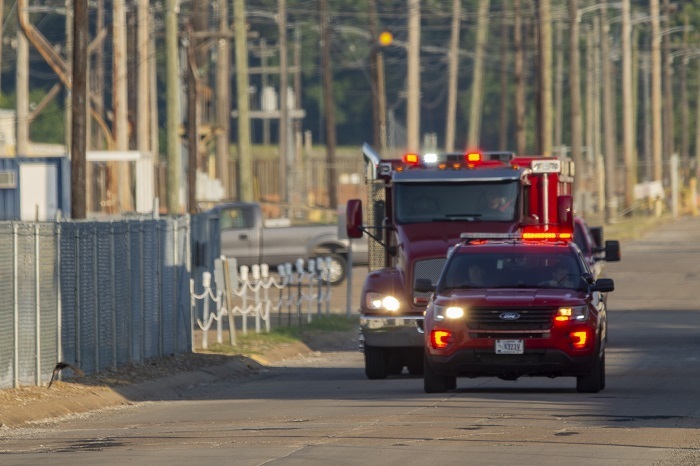 EM’s Paducah Site maintains a mutual aid agreement with the West McCracken Fire District, which provides a framework for the site to provide community support.
PADUCAH, Ky. – A local fire chief recently praised the EM Paducah Site’s fire department for the team’s community-minded approach to emergency response.
From March to June this year, the fire department at the Paducah Site responded to 52 mutual aid requests from the West McCracken Fire District. A mutual aid agreement is a written agreement between agencies, organizations or jurisdictions to lend assistance across jurisdictional boundaries.
In a recent letter, the district’s chief, Donald Elrod, acknowledged the Paducah Site fire department for its quick response time to emergencies in the community and praised the teamwork demonstrated between the two departments' joint training sessions.
As a result of EM’s partnership with the fire district, the West McCracken organization scored well on an audit conducted by the Insurance Services Office (ISO). According to Elrod, only 3,583, or a little more than 10% of fire departments in the entire United States received a Class 3 designation, which included West McCracken Fire District. This list of organizations includes both paid and volunteer fire departments. The Class 3 designation refers to the fire districts population being within 5 miles of a fire station and within 1,000 feet from a hydrant. There are multiple factors that go into the rating such as fire apparatus and available trained personnel.
“It was the (EM Paducah Site) fire services personnel’s response to structure fires; their training with us every Monday night; their individual credentials; and our overall ability to work together as a team on a multitude of all types of emergencies that impressed the ISO auditor,” Elrod stated in his letter.
The newly achieved audit score demonstrates enhanced fire protection for the community and resulted in insurance savings for both the county and local residents.
“Safety is always the number one priority at the site and for our community,” Portsmouth/Paducah Project Office Manager Joel Bradburne said. “Continuing to strengthen DOE’s partnership with local emergency response organizations benefits not only the community but our mission at the Paducah Site as well.”
-Contributors: Dylan Nichols, Jessica Vasseur
  From left: Chip Chipres, Brian Abbot, Chris Hall and Albert Rodriguez with Hanford Site contractor Bechtel National Inc. are four of the more than 100 employees who helped implement recent cybersecurity controls at the Waste Treatment and Immobilization Plant.
RICHLAND, Wash. – EM Office of River Protection (ORP) contractor Bechtel National Inc. (BNI) recently took a major step forward when the Hanford Site Waste Treatment and Immobilization Plant (WTP) received a federal authorization certifying that the WTP’s information systems comply with DOE cybersecurity requirements, a necessary step to keep the plant safe during commissioning and operations.
“This authorization helps keep us on a sound path to start treating tank waste under the Direct-Feed Low-Activity Waste Program in early calendar year 2025,” said Brian Vance, EM Office of River Protection and Richland Operations Office manager. “It demonstrates the plant, personnel and procedures meet or exceed the Department’s cybersecurity requirements for operating nuclear facilities.”
Earning the authorization follows a multiyear effort by BNI and site integration and services contractor Hanford Mission Integration Solutions to transfer vital plant systems and more than 1,000 BNI computer users to the Hanford network.
“Receiving the authorization is the culmination of a five-year effort by more than 100 plant personnel across multiple departments,” said Jason Stidham, WTP chief information officer for BNI, the prime contractor designing, building and commissioning the plant. “The authorization would not have been possible without the significant teamwork and diligence demonstrated by all involved.”
During direct-feed low-activity waste operations, Hanford tank waste will be heated in large melters and mixed with glass-forming materials in the WTP’s Low-Activity Waste Facility. The mixture will then be poured into stainless steel containers and allowed to cool before being disposed of in a special landfill on the Hanford Site called the Integrated Disposal Facility.
-Contributor: Tyler Oates


AIKEN, S.C. – A researcher with EM’s Savannah River National Laboratory (SRNL) has earned the honor of laboratory fellow — the highest scientific and engineering achievement within the laboratory — for her outstanding contributions to her area of expertise, SRNL and the nation.
As a senior technical adviser in the Environmental and Legacy Management Directorate of SRNL, Carol Eddy-Dilek contributed significantly to SRNL, the Savannah River Site (SRS) and DOE missions since joining SRNL in 1989.
Eddy-Dilek successfully applied her knowledge of geology and environmental sciences, and her program management skills to advance SRNL’s competencies in environmental characterization and remediation. Her responsibilities included leading and supporting high-quality applied technology development research, as well as strategies to support high-priority needs for EM and DOE’s Office of Legacy Management (LM).
Appointment to the position of fellow is granted by the laboratory director upon the recommendation of the Fellow Committee and Review Panel.
“I am proud of Carol for her numerous accomplishments,” said Laboratory Director Vahid Majidi. “Over the past three decades, she has produced technology resulting in significant cost savings to the DOE’s soil and groundwater remediation programs. She is an eminent expert and a trusted adviser, as well as a respected mentor to the next generation of scientists and engineers advancing remediation and long-term monitoring strategies. Carol is well deserving of the title of fellow.”
Eddy-Dilek was a classic geologist when she first came to SRNL to oversee the completion of the SRS geologic map and never imagined having the opportunity to work on such a wide diversity of complex and challenging groundwater and soil contamination problems.
“SRNL defines the concept of putting science to work,” says Eddy-Dilek. “We have provided actionable solutions to difficult problems at many federal sites contaminated with a variety of radionuclides, mercury and volatile organic compounds using applied geological, hydrologic, geophysical and geochemical tools. It has been incredibly challenging and rewarding at the same time.”
Over the last two decades, Eddy-Dilek managed over 50 national technical assistance team evaluations of high-priority issues related to environmental restoration in concert with researchers across SRNL to focus on timely project delivery and cost savings for EM. Additionally, she and her teams developed new initiatives within the federal complex, including the Department of Defense, Environmental Protection Agency, LM, International Programs and EM field sites, including Portsmouth, Paducah, Los Alamos, Oak Ridge and Hanford.
More recently, Eddy-Dilek and scientists at Lawrence Berkeley National Laboratory (LBNL) worked collaboratively to develop new cost-effective strategies for long-term monitoring, incorporating geophysical and artificial intelligence tools that use the laboratory’s unique competencies and innovative technologies. Additionally, she led the development of a new paradigm of long-term monitoring that EM can implement across its complex and extend to LM sites to improve the quality of monitoring and reduce costs. This multimillion-dollar project has been mentioned multiple times during testimony to the U.S. Congress and has immense potential benefit to SRNL and other sites.
-Contributor: Scott Shaw
|
|